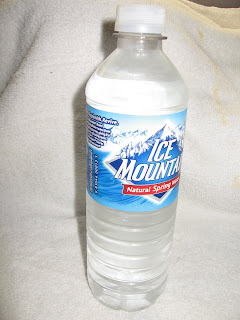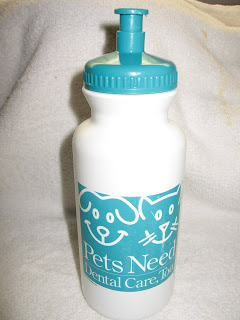Who knew this could be so bad?

About two years ago, I cut back drastically on the amount of soft drinks I drank. (I would like to say I quit completely, but there are some days when I just gotta have a Mt. Dew.) I figured I didn't need the carbonation or the high fructose corn syrup, which is the leading cause of Type II diabetes if you ask my opinion. I can't stand the aftertaste of most artificial sweeteners (What do those chemicals do to you?) and besides, plain water quenches your thirst better than sweet fizzy drinks anyway.
I don't like the taste of most city water, but I have great tasting water at home from my local township water association. The first step, drinking more water at home, was easy. For times when I wasn't near my home faucet, I started buying a lot of bottled water, to take to work, to have in the car, or for travel.
I had concerns about the environmental impact of the plastic, but I felt I was doing my part by reusing the bottles several times, filling them up from home, and then recycling the discarded empties when they got too gross to use. Now I find out there is more to consider than whether the bottle goes into the landfill or the recycle bin.
A recent article in the Cincinnati Nature Center's newsletter, by naturalist Dennis Smoyer, a friend and fellow birder, has made me rethinking my use of disposable plastic water bottles.
Some factoids I gleaned from his article:
28 billion bottles of water are purchased in the USA each year.
Between 80-90% of those bottles end up in the landfill or as litter.
It takes 2 liters of water to produce 1 liter of drinking water.
It takes 1/4 liter of crude oil to produce and ship each liter of water.
Clearly, buying bottled water has a huge environmental impact. Obviously, I need to make a change to reusable water bottles. But, what kind?
Brief detour: There are seven types of plastic currently in use, each with a number code inside the "chasing arrows" recycling symbol. Not all of these plastics are easily recycled, despite the misleading symbol.
#1 plastics are made of PET (PolyEthylene Terephthalate). Most soda and water bottles bottles, like the Ice Mountain bottle above, are PET plastic. These bottles are lightweight, shatter-resistant, and easily recycled. They are considered disposable, and therein lies the problem.
#2 plastics consist of HDPE (High Density PolyEthylene.) Detergent bottles and milk jugs are made of HDPE. They are inexpensive, sturdy, and can also be recycled readily. You can buy reusable water bottles made of HDPE, and, as it turns out, I have one.
I have used this bottle since January, and it isn't bad, but the drink spout has begun to fail after repeated pushes and pulls, and now it leaks or I suck in air if it isn't adjusted quite right. I have also dropped and broken two other HDPE water bottles, so they aren't very permanent.
#3 through 6 plastics are used in dry cleaning bags and drinking straws, Styrofoam packing peanuts and produce bags, plastic food wraps and pill vials, CD cases and a million other things in our plasticized world. While recyclable in theory, practically speaking it is hard to find anyone to take these off your hands.
And then, there is category #7: "Other." This catch-all label includes reusable food containers, Tupperware, and reusable water bottles. Nalgene is a popular brand name water bottle made of #7 plastic. Environmentally aware consumers have being toting their Nalgene water bottles around for quite a while, but reports linking the compound BPA (BisPhenol A) found in this type of plastic to various health risks have put a bit of a damper on their enthusiasm.
In response to consumer demands, BPA-free reusable plastic water bottles are now available. Camelbak and the newer Nalgenes are BPA-free. If you have an older bottle, you may want to replace it. Remember, these bottles are designed for cold water only. Exposing the bottle to heat or carbonation, or using harsh or abrasive cleaners will increase the risk of the BPA leaching out of the plastic and into your drinking water. Don't wash this type bottle in a dishwasher.
My Camelbak bottle, with the CNC logo on it, was $15.95, less my member discount. Pricey, but if it holds up well, it will be worth it. I figure it will pay for itself once I have passed up a dozen $1.50 bottles of water at the quickie-mart. (Why does a bottle of water cost more than a bottle of soda, when soda is water + additives and water is ... just water?)
Some people are happy using aluminum water bottles like these. Aluminum bottles should be lined to prevent a metallic taste, and there is an unproven association between aluminum and Alzheimer's disease.
Perhaps the best answer is stainless steel. When I read this, I thought, "Now how am I going to carry a steel bottle around with me when I am hiking or birding?" This model is surprisingly lightweight and has a carabiner clip for hooking it to your day back or bird bag. It comes in bright colors, but no cool logo.

I bought one of these, too, to try out and see how I like it. I'm not sure about the opening, though. I will have to see how it performs. Also, it only holds 20 oz, while the Camelbak holds four ounces more. This style was $11.95 at CNC.
I usually go through two 500ml bottles of water per day at work. I'll need to fill and take both my new bottles with me every day if I am going to break my PET habit. I don't know how good I will be at remembering to clean and fill my bottles every day. Foregoing the convenience of grabbing a disposable bottle in the morning will take some time, but I'm determined to make this work.
"Such a small step," you might think. "One person's choice to buy reusable bottles instead of disposals can't make that much difference, can it?" Maybe not, but neither does picking up one piece of litter or recycling one newspaper. If we all do our part, they will add up to significant change. I will continue to do my little bits to help Mother Earth, and hope you will, too.
[Thanks to Dennis for the inspiration for this post, and for some of the information above.]





4 comments:
*standing up at my PC and applauding you*
When I dare to drink water (instead of my Frappuchinos or RockStar liquid breakfast) I use a really cool bottle (can't remember which plastic it's made of) that I got at Target.
I like your CNC cup and the fancy steel one. Good for you! One step at a time, girlfriend.
Why does a bottle of water cost more than a bottle of soda, when soda is water + additives and water is ... just water? Because people are stoopit?
Katdoc, I read your blog every once in a while but do not comment. This one will make up for all the blank space I've left behind me. I hope you won't mind.
Access to water, and the use of bottled water, are issues I've worked on as an educator for a long time. I rejoice when I see that someone gets it and changes their practice, and then encourages others to do the same. Good on you.
The environmental and health issues you raise related to plastic water bottles are key, and I'm glad you raised them. But the huge upsurge in bottled water consumption also raises larger ecological issues such as the rapid depletion of aquifers. Or equity issues, such as when Coca Cola uses municipally treated tap water to make Dasani and then turns a huge profit off it. And there is a human rights dimension as well -- most countries in the UN framework understand water to be a human right. (Who do you think consistently opposes this? Canada and the United States ...) If water is a human right, then it means we all have fair and equitable access to it. Yet across the global South, often the only access to potable water is bottled water or community taps that have been padlocked by private companies, who charge people for every mugful. These are policies supported by our governments (privatization of essential services, like water, is often a condition of foreign aid from countries like Canada and the US), and every time we as educated citizens buy a bottle of water, we're saying indirectly, that it's okay.
For so, so many reasons, bottled water is almost always not ok. And even when it is okay --say in a community like Walkerton ON, where the town water was polluted with waste from industrial hog farms and people died as a result, it is only okay as a temporary measure. We need water systems that work for everyone.
Thanks for this blog post, and apologies for taking up so much space!
LOG:
Thanks so much for the input, and no apologies needed. You bring up some terrific points that I had never considered, or even knew about, in regards to bottled water. Hence, the title of my post. I really didn't know any better. Here I was, trying to be all healthy, and I am not only leaving a huge carbon footprint, I am also taking water from the mouths of babies and contributing to corporate greed. Geez, I suddenly feel worse instead of better.
I'll finish off the bottled water I have purchased, and reuse the bottles a few more times, but then I'm cutting the bottle habit and going green(er).
Keep on fighting the good fight and educating the world. Thanks again for your visits, whether you comment or not, and for this important information.
~Kathi
Post a Comment